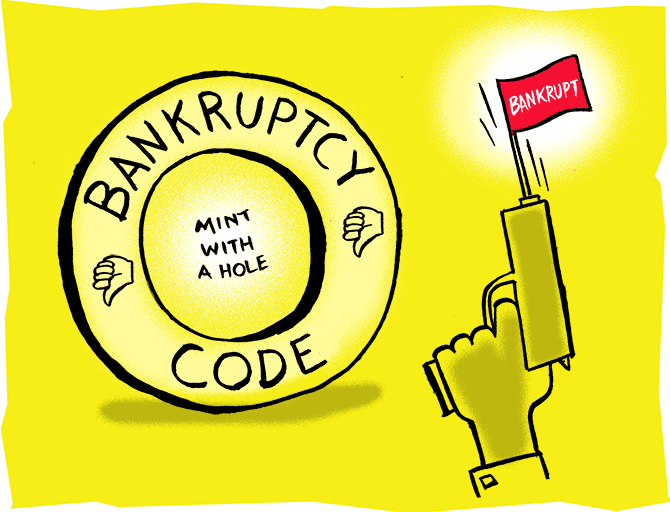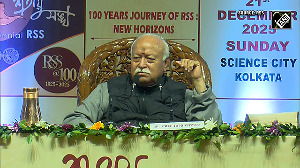Somasekhar Sundaresan finds out that the new Insolvency and Bankruptcy Code has serious drawbacks.
Illustration: Dominic Xavier/Rediff.com.

The Supreme Court of India is reported to have blessed a settlement between a litigating lender and a corporate borrower after the process for insolvency under the newly-legislated Insolvency and Bankruptcy Code had been set in motion.
The parties settled their differences and their settlement terms were approved setting aside the process, using the court’s powers under Article 142 of the Constitution.
This is a material development and points to the need to take a close re-look at some of the policy choices made in the new bankruptcy law, which is now about nine months old.
First, the process brings on par with lenders, who may have thousands of crores in loans to a borrower, any operational creditor (say, supplier of furniture) who claims dues of just over a lakh of rupees, in the legal capacity to trigger the “resolution process” under the code.
The grounds on which the National Company Law Tribunal might refuse to set the process in motion are limited -- for operational creditors, the primary ground is the existence of disputes before the claim is made.
In other words, only uncontested dues on which there is a default would lead to the bankruptcy law being attracted.
The case in the Supreme Court was not of an operational creditor but of a financial creditor, but that does not matter for the analysis here.
Second, once the resolution process is set in motion, a moratorium kicks in. No debt can be enforced on the company against whom the claim was made.
While this might seem normal about “bankruptcy protection”, it works well only for companies that are truly bankrupt.
For companies that are solvent but have bona fide disputes over claims made by counter parties, this results in a prompt trigger of pariah status.
If your promises cannot be enforced against you, no one would transact with you. This is all the more reason for the setting of the process into motion to be done with a great deal of care and caution.
Until a recent ruling by the National Company Law Appellate Tribunal, various benches of the National Company Law Tribunal, which administers the new law, had taken a position that unless actual litigation had been initiated, no claim of any operational creditor could be regarded as disputed.
Third, not only would a moratorium kick in, but also an “interim resolution professional” would stand vested with all the powers of the board of directors of the company.
The powers of the board of directors would stand suspended forthwith.
The moratorium and the change of control are certainly fantastic features to handle the best interests of stakeholders of a truly insolvent company but they are certainly poisonous and not medicinal for a company that is solvent but can be threatened with initiation of the resolution process.
Therefore, the very threat of a possible initiation of this process leads to coerced recovery that could in fact hurt a larger segment of lenders, who truly have the long-term financial interests of the company at heart.
This is why HDFC Bank managing director Aditya Puri’s statement that resorting to the insolvency courts is not the best solution unless the borrower is a wilful defaulter makes immense sense.
In his reported words, this is a law of “last resort” and not the “first thing”.
The capacity of any goods or services provider -- an operational creditor -- to set such a serious process in motion as the first thing, is worrisome.
Once the moratorium kicks in, even the financial creditors of a company for which a moratorium has kicked in, would get hit and be unable to recover their dues.
Indeed, the creditors’ committee that is supposed to work during the moratorium could comprise a majority of creditors, who see a future in the company and can drown out the voice of the lone creditor who does not.
Therefore, theoretically, if one does call the bluff of an aggressive operational creditor or a disgruntled financial creditor, and stays the course, the initiation of the resolution process can eventually come to mean nothing.
However, this is theoretical and not practical. Once the world at large rearranges its view of a company whose promises cannot be enforced and has to deal with a chartered accountant or company secretary acting as a resolution professional without experience in running a business, even a reasonable view of creditworthiness of a doubtful debtor has to change to a perception of a bad debtor.
In this context, the coding in the law that entails no roll-back once the resolution process is set in motion is a hard and blunt weapon of last resort, which can cause more injury than warranted when used as the first resort.
When the Supreme Court uses Article 142 “for doing complete justice” and takes on record the settlement terms between a creditor, who has set the resolution process in motion and the debtor on whom a moratorium has kicked in, it is because really unjust and unintended consequences can emerge from the working of this law.
For the long-term health of the effectiveness of the bankruptcy law, it would have been better to help the new law build its core strengths by generating capacity and getting the resolution professionals and bankruptcy professionals to build bandwidth and gain competence before unleashing the burden of handling the entire society’s corporate debts on them.
The burden of private corporate debt recovery could have been held back from imposing itself on the enforcement machinery until the immediate task of serious financial debts working itself through.
The Supreme Court, which has powers to intervene and roll back a moratorium in the interests of justice, having used this power, it is time for a serious and quick rethink and pilot short amendments to make this law effective with a review scheduled for after two years.











